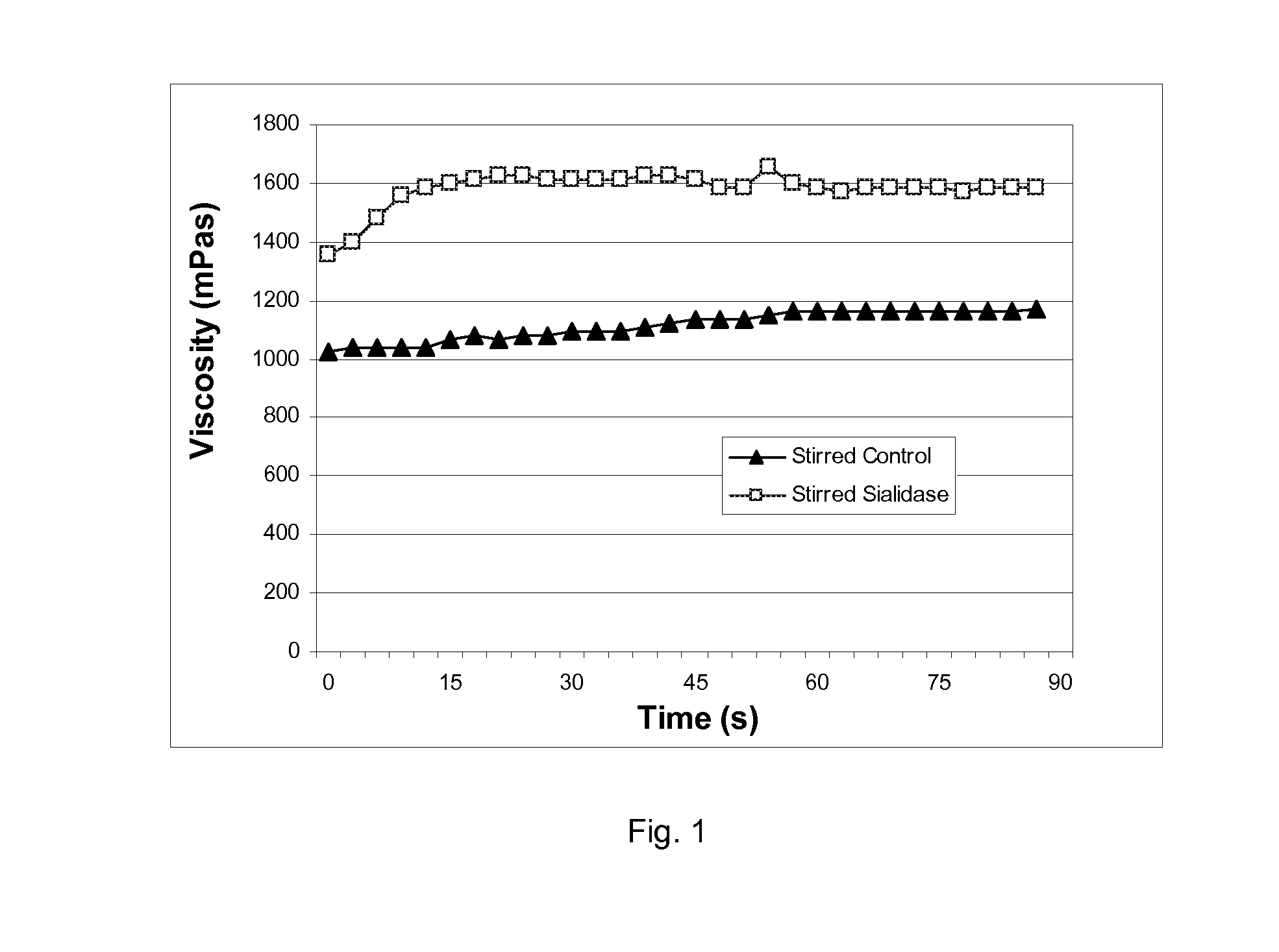Use of sialidase in dairy technology
- Summary
- Abstract
- Description
- Claims
- Application Information
AI Technical Summary
Benefits of technology
Problems solved by technology
Method used
Image
Examples
example 1
Preparation of Small Scale Fermented Skim-Milk Using Sialidase ZJW
[0108]Cloning, expression and purification of a sialidase enzyme from Penicillium chrysogenum has been described previously in WO08101893. This sialidase was named ZJW, produced from the filamentous fungus Aspergillus niger and used to obtain examples of the effect of sialidases in the production of sour dairy preparations. 40 gram of skim milk powder (Nilac, NIZO, the Netherlands) was dissolved in 400 ml of tap-water and distributed over four 100 ml capped bottles. The 4 bottles were treated as described in Table 1. Sialidase ZJW was added to bottles 2 and 3 in 10 and 50 mg / l respectively. Bottles 2 and 3 were subsequently incubated for 4 hours at 40 degrees Celsius. After this, all bottles were stored refrigerated during the night. Subsequently, all bottles were warmed to 40 degrees Celsius for 30 minutes, before addition of 0.004 U / I starter culture Delvo®-YOG CY-121 (DSM Food-Specialties, the Netherlands; CY=class...
example 2
Preparation of Yoghurt Using Sialidase ZJW
[0113]1.5 liter homogenized semi-skimmed cow milk (1.5% fat, 3.5% protein) was heated for 30 min at 85° C. in a water bath. The milk was rapidly cooled down to 42° C. using iced water. The sialidase ZJW was added to the milk at a level of 10 mg / L and incubated for 2 hours at 42° C. A control sample (without sialidase) was treated the same way. The milk then was inoculated with starter culture Delvo®-YOG CY-121 (DSM Food-Specialties, the Netherlands) at a level of 4 U / 1000 L. For set yoghurt the inoculated milk was poured into its final package before fermentation at 42° C. For stirred and drinking the fermentation took place in 3 liter vessels. The process was stopped when the yoghurt reached pH4.5, which took about 4 hours. After fermentation the yoghurt was pumped through a homogenizer (APV Homogenizer Rannie) without pressure for stirred yoghurt production. For drinking yoghurt a homogenization at 100 bar was performed. All yoghurts were ...
example 3
Measurement of Sialic Acid Content
[0117]BioVision's Sialic Acid Assay Kit (CA, USA) provides a simple and convenient means of measuring free sialic acid in a variety of biological samples. The kit utilizes an enzyme coupled reaction in which free sialic acid is oxidized resulting in development of the Oxi-Red probe to give fluorescence (Ex / Em=535 / 587 nm) and absorbance (O.D.=570 nm). The kit measures sialic acid in the linear range of 0.1 to 10 nmol with a detection sensitivity ˜1 μM concentration.
[0118]Samples can be tested for free sialic acid or hydrolyzed to measure bound sialic acid as well using the kit of Biovision. For measurement of total sialic acid, first a hydrolysis at mild acid conditions should be performed. The sample from a sour dairy preparation is hydrolysed in 0.05 M H2SO4 at 80 degrees Celsius at a concentration of about 1 mg protein / ml. Samples for sialic acid determination are removed at appropriate times and stored at −20° C. until analysis. After adjustment ...
PUM
| Property | Measurement | Unit |
|---|---|---|
| Temperature | aaaaa | aaaaa |
| Temperature | aaaaa | aaaaa |
| Temperature | aaaaa | aaaaa |
Abstract
Description
Claims
Application Information
 Login to View More
Login to View More - R&D
- Intellectual Property
- Life Sciences
- Materials
- Tech Scout
- Unparalleled Data Quality
- Higher Quality Content
- 60% Fewer Hallucinations
Browse by: Latest US Patents, China's latest patents, Technical Efficacy Thesaurus, Application Domain, Technology Topic, Popular Technical Reports.
© 2025 PatSnap. All rights reserved.Legal|Privacy policy|Modern Slavery Act Transparency Statement|Sitemap|About US| Contact US: help@patsnap.com

